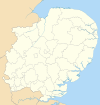East Cambridgeshire
East Cambridgeshire District | |
|---|---|
 East Cambridgeshire shown within Cambridgeshire | |
| Sovereign state | United Kingdom |
| Constituent country | England |
| Region | East of England |
| Non-metropolitan county | Cambridgeshire |
| Status | Non-metropolitan district |
| Admin HQ | Ely |
| Incorporated | 1 April 1974 |
| Government | |
| • Type | Non-metropolitan district council |
| • Body | East Cambridgeshire District Council |
| • Leadership | Alternative - Sec. 31 (Conservative) |
| • MPs | Stephen Barclay Lucy Frazer |
| Area | |
| • Total | 251.5 sq mi (651.3 km2) |
| Area rank | 62nd (of 309) |
| Population (mid-2019 est.)[2] | |
| • Total | 89,840 |
| • Rank | 271st (of 309) |
| • Density | 360/sq mi (140/km2) |
| • Ethnicity | 95.9% White 1.0% S.Asian 1.1% Mixed 1.8% Chinese or Other |
| Time zone | UTC0 (GMT) |
| • Summer (DST) | UTC+1 (BST) |
| ONS code | 12UC (ONS) E07000009 (GSS) |
| OS grid reference | TL535799 |
| Website | www |
East Cambridgeshire (locally known as East Cambs) is a local government district in Cambridgeshire, England. Its council is based in Ely. The population of the District Council at the 2011 Census was 83,818.[3]
The district was formed on 1 April 1974 with the merger of Ely Urban District, Ely Rural District and Newmarket Rural District.
According to a report by the Halifax bank in 2004, East Cambridgeshire has the fastest population growth rate of any British local authority other than the City of London.[4]
Archaeology[]
The recent Fenland survey of archaeological finds mentions an enumeration of findings made between 1884 and 1994 in the region to the north of Devil's Dyke and Cambridge, from the Stone Age, the Bronze Age and the Iron Age (the region south of Devil's Dyke is not yet included in the survey). By far the greatest quantities of bronze objects found in England were discovered in East Cambridgeshire.
The most important Bronze Age finds were discovered in Isleham (more than 6500 pieces), Stuntney, Soham, Wicken, Chippenham, Coveney, Mepal and Wilburton. These findings include swords, spear-heads, arrows, axes, palstaves, knives, daggers, rapiers, armour, decorative equipment (in particular for horses) and many fragments of sheet bronze. The greater part of these objects have been entrusted to the Moyse's Hall Museum in Bury St Edmunds while other items are in the University of Cambridge Museum of Archaeology and Anthropology in Cambridge. Other finds include traces of cremations and barrows, golden torques, an extensive ditch system and a wooden track-way between Fordey Farm (Barway) and Little Thetford.[5] Bronze razors have also been found and it is well known that Celts shaved their cheeks.[6]
Settlements in East Cambridgeshire[]
- Aldreth
- Ashley
- Barway
- Bottisham
- Brinkley
- Burwell
- Chettisham
- Cheveley
- Chippenham
- Coveney
- Dullingham
- Ely (City)
- Fordham
- Haddenham
- Isleham
- Little Downham
- Little Thetford
- Littleport
- Lode
- Longmeadow
- Mepal
- Prickwillow
- Pymoor
- Queen Adelaide
- Reach
- Soham (Town)
- Stetchworth
- Stretham
- Stuntney
- Sutton
- Swaffham Bulbeck
- Swaffham Prior
- Upware
- Wicken
- Wilburton
- Witcham
- Witchford
- Woodditton
See also[]
- East Cambridgeshire local elections
- Isleham Hoard
- Mereham
References[]
- ^ "Standard Area Measurements (2016) for Administrative Areas in the United Kingdom". Office for National Statistics. 1 February 2017. Retrieved 9 February 2017.
- ^ "Population Estimates for UK, England and Wales, Scotland and Northern Ireland, Mid-2019". Office for National Statistics. 6 May 2020. Retrieved 6 May 2020.
- ^ "Non Metropolitan District population 2011". Neighbourhood Statistics. Office for National Statistics. Retrieved 13 July 2016.
- ^ http://news.bbc.co.uk/1/hi/uk/4122731.stm news.bbc.co.uk
- ^ Hall, David (1994). Fenland survey : an essay in landscape and persistence / David Hall and John Coles. London;English Heritage. pp. 81–88. ISBN 1-85074-477-7.
- ^ Hall, David (1994). Fenland survey : an essay in landscape and persistence / David Hall and John Coles. London;English Heritage. p. 4. ISBN 1-85074-477-7.
- East Cambridgeshire District
- Non-metropolitan districts of Cambridgeshire


